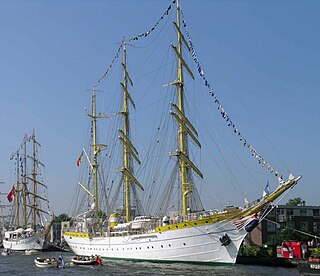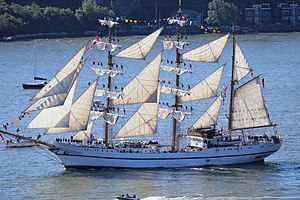
A tall ship is a large, traditionally-rigged sailing vessel. Popular modern tall ship rigs include topsail schooners, brigantines, brigs and barques. "Tall ship" can also be defined more specifically by an organization, such as for a race or festival.

Europa is a steel-hulled barque registered in the Netherlands. Originally she was a German lightship, named Senator Brockes and built in 1911 at the H.C. Stülcken & Sohn shipyard in Hamburg, Germany. Until 1977, she was in use by the German Federal Coast Guard as a lightship on the river Elbe. A Dutchman bought the vessel in 1985 and in 1994 she was fully restored as a barque, a three-mast rigged vessel, and retrofitted for special-purpose sail-training.

The Amerigo Vespucci is a tall ship of the Italian Navy named after the explorer Amerigo Vespucci. Its home port is La Spezia, Italy, and it is in use as a training ship.

Gorch Fock I is a German three-mast barque, the first of a series built as school ships for the German Reichsmarine in 1933.

USCGC Eagle (WIX-327), formerly the Horst Wessel and also known as the Barque Eagle, is a 295-foot (90 m) barque used as a training cutter for future officers of the United States Coast Guard. She is one of only two active commissioned sailing vessels in the United States military today, along with USS Constitution which is ported in Boston Harbor. She is the seventh Coast Guard cutter to bear the name in a line dating back to 1792, including the Revenue Cutter Eagle.

A barquentine or schooner barque is a sailing vessel with three or more masts; with a square rigged foremast and fore-and-aft rigged main, mizzen and any other masts.

The Gorch Fock is a tall ship of the German Navy, built in 1958 as a replacement for the original Gorch Fock built in 1933 which was taken as war reparations by the Soviet Union after World War II, renamed Tovarishch, and returned to Germany in 2003.

A training ship is a ship used to train students as sailors. The term is mostly used to describe ships employed by navies to train future officers. Essentially there are two types: those used for training at sea and old hulks used to house classrooms. As with receiving ships or accommodation ships, which were often hulked warships in the 19th Century, when used to bear on their books the shore personnel of a naval station, that were generally replaced by shore facilities commissioned as stone frigates, most "Training Ships" of the British Sea Cadet Corps, by example, are shore facilities.

Statsraad Lehmkuhl is a three-masted barque rigged sail training vessel owned and operated by the Statsraad Lehmkuhl Foundation. It is based in Bergen, Norway and contracted out for various purposes, including serving as a school ship for the Royal Norwegian Navy.

Mircea is a three-masted barque, built in 1938 in Hamburg by the Blohm & Voss shipyard as a training vessel for the Romanian Navy. Her design is based on the successful plans of Gorch Fock; the last of a series of four sister ships. The ship is named after the Wallachian Voivode, Mircea the Elder. After World War II she was temporarily taken over by the USSR, but later returned to Romania. In 1966, she was overhauled by Blohm & Voss.

ARM Cuauhtémoc is a sail training vessel of the Mexican Navy, named for the last Mexica Hueyi Tlatoani Cuauhtémoc who was captured and executed in 1525.

NRP Sagres is a tall ship and school ship of the Portuguese Navy since 1961. As the third ship with this name in the Portuguese Navy, she is sometimes referred to as Sagres III.

SegelschulschiffNiobe was a tall ship used by the Reichsmarine to train cadets and aspiring NCOs. She sank during a white squall on 26 July 1932, with the loss of 69 lives. A memorial monument to Niobe was erected at Gammendorfer Strand on Fehmarn island, within view of the site of the sinking.
Operation Sail refers to a series of sailing events held to celebrate special occasions and features sailing vessels from around the world. Each event is coordinated by Operation Sail, Inc., a non-profit organization established in 1961 by U.S. President John F. Kennedy, and must be approved by the United States Congress. Often referred to as OpSail or Op Sail, the event has the goals of promoting good will and cooperation between countries while providing sail training and celebrating maritime history. It is also sometimes erroneously referred to as "Tall Ships". While the tall ships form the centerpiece of the event, smaller sailing vessels also participate.

INS Tarangini is a three-masted barque, commissioned in 1997 as a sail training ship for the Indian Navy. She is square rigged on the fore and main masts and fore-and-aft rigged on the mizzen mast. She was constructed in Goa to a design by the British naval architect Colin Mudie, and launched on 1 December 1995. In 2003–04, she became the first Indian naval ship to circumnavigate the globe.

ARA Libertad (Q-2) is a steel-hulled, full-rigged, class "A" sailing ship that serves as a school vessel in the Argentine Navy. One of the largest and fastest tall ships in the world, holder of several speed records, she was designed and built in the 1950s by the Río Santiago Shipyard, Ensenada, Argentina. Her maiden voyage was in 1961, and she continues to be a training ship with yearly instruction trips for the graduating naval cadets as well as a traveling goodwill ambassador, having covered more than 800,000 nautical miles (1,500,000 km) across all seas, visited about 500 ports in more than 60 countries, and trained more than 11,000 navy graduates.

Cisne Branco is a tall ship of the Brazilian Navy based at Rio de Janeiro, Brazil, to diplomatic operations worldwide. The name means "white swan." It is a full-rigged ship built in Amsterdam, Netherlands by Damen Shipyard. Her keel was laid on 9 November 1998, and she was christened and launched on 4 August 1999, delivered to the Brazilian Navy on 4 February 2000. The vessel was commissioned as a Brazilian naval vessel on 9 March 2000. Its sister ship is Stad Amsterdam.

The Tall Ships Races are races for sail training "tall ships". The races are designed to encourage international friendship and training for young people in the art of sailing. The races are held annually in European waters and consists of two racing legs of several hundred nautical miles, and a "cruise in company" between the legs. Over one half of the crew of each ship participating in the races must consist of young people.

Simón Bolívar is a training vessel for the Venezuelan Navy. She sails from the home port of La Guaira and is a frequent participant in tall ship events. She is named after Simón Bolívar, the liberator of Bolivia, Colombia, Peru, Ecuador, Panama and Venezuela.

BAP Unión (BEV-161) is a training ship of the Peruvian Navy built between 2012–2015 by Shipyard Marine Industrial Services of Peru, known as SIMA. It is a four-masted, steel-hulled, class "A" barque, composed of 38 steel modules. It has a total length of 115.50 m ; a beam of 13.50 m ; a draft of 6.50 m ; an air draft of 53.50 m ; a displacement of 3,200 tonnes; a speed of 12 knots (22 km/h) and a crew of 250 officers and trainees. The ship's name honors a Peruvian corvette that took part in the first stage of the 1879–1883 War of the Pacific as part of a naval squadron under the command of Miguel Grau, a hero of the Peruvian Navy.




















